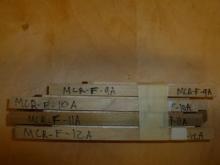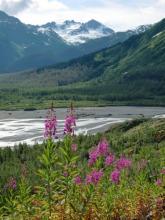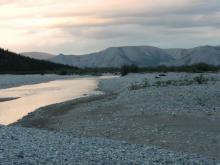What Are They Doing?
Growth rings, also known as trees rings or annual rings, are annual layers of tree growth that can be seen when looking at the cross section of a tree trunk. Looking at the rings, you can determine the age of the tree by counting the rings. By looking at rings, you can also study the response of the tree to environmental conditions like a really dry or wet year. The study of tree rings is called dendrochronology.
The research team studied mostly white spruce trees on the North Slope of Alaska. They collected samples from the boreal forest and further north around the tree line (the place too far north for trees to grow). They collected samples by coring trees, taking tree measurements, and recording observations about the environment around the trees.
Using this study, the research team looked at environmental conditions of the past and tried to determine which conditions have the greatest impacts on tree growth. The records were compared to similar data from around the entire arctic to better understand the response of boreal forests to changes in seasonality.
Where Are They?
The team camped and conducted their research in the Arctic National Wildlife Refuge (ANWR) in the Firth River area, in northeastern Alaska. The Arctic Refuge is the largest National Wildlife Refuge, consisting of around 19,000,000 acres. It was established for many reasons, including the conservation and preservation of over 300 wildlife species, to fulfill international treaty obligations, and to provide opportunities for continued subsistence uses. Inupiat Eskimo and Gwich’in Indian peoples primarily inhabit the Arctic National Wildlife Refuge. To arrive at their field site, the research team chartered a flight on a small plane into their field site.
Latest Journals
Rosanne D'Arrigo is a Lamont Research Professor and Associate Director of the Biology and Paleo Environment Department at the Lamont-Doherty Earth Observatory. Her current research is in the Tree-Ring Research Laboratory, where scientists are dedicated to expanding the use and application of tree-ring research around the world to improve understanding of past climate and environmental history. Dr. D'Arrigo has been involved with educational outreach for many years via annual open houses, exhibits, and seminars. Learn more about Dr. D'Arrigo and her work at her faculty webpage.
Kevin Anchukaitis is an Assistant Research Professor in the Biology and Paleo Environment Department at Lamont-Doherty Earth Observatory. He works in the Tree-Ring Laboratory, and his research focuses on developing and interpreting high-resolution proxy records of climate variability. To learn more about Dr. Anchukaitis, please visit his webpage.





